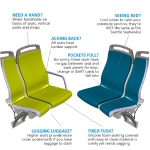
How to Select a Rail Seat Cushion Material: Top 4 Factors
Explore the four key factors that rail car design engineers should consider when choosing seat cushions for comfort, safety, and long-term durability.
How to Ensure Rail Car Safety: Key Standards EN 45545-2 and 49CFR238/ NFPA 130
Explore critical rail industry specifications, such as EN 45545-2 and NFPA 130, and highlight how Rogers innovative materials surpass these standards.
Winter-Proof Your Train Design with ARLON® Water-Resistant Flexible Heaters
When temperatures plummet and snow covers the ground, trains face unique challenges to keep running smoothly. One of the most critical components affected by harsh winter conditions is the train door.
One Substrate, Multiple Options
Substrates are not only available in multiple copper and ceramic thicknesses, but also various design options and product features exist to fit the specific customers’ needs. In this blog, we take a closer look at these features.
Olivier's Twist Blog, Aerospace & Defense, Automotive & EV/HEV, General Industrial, Major Appliances, Rail, Wind & Solar
Applications for Metallized Ceramic Substrates
Among other measures, voltage, current and mission profile are critical parameters to consider in the selection of the substrate for a given application. In this blog, we look at common applications for multi-chip power modules to understand the rationale behind each technology.
Olivier's Twist Blog, General Industrial, Major Appliances, Rail, Wind & Solar
Frequently Asked Power Electronics Questions
In this edition we would like to answer a few frequently asked questions to benefit those new to the power electronics community and a refresher training for those experienced in the industry as well.
Olivier's Twist Blog, Aerospace & Defense, Automotive & EV/HEV, General Industrial, Major Appliances, Rail, Wind & Solar
Influence of Copper Grain Size on Assembly Process and Substrate Performance
The copper grain size is an important property of Direct Bonded Copper (DBC) substrates. Variations in the copper grain size cannot be fully excluded, but large variations may affect the subsequent assembly processes or the performance of DBC substrates. Module manufacturers can rely on the experience and competence of Rogers' Power Electronics Solutions team to deliver substrates with a consistent grain size.
Olivier's Twist Blog, Aerospace & Defense, General Industrial, Major Appliances, Rail, Wind & Solar
Metallized Ceramic Substrates for the New Decade
Direct Bonded Copper (DBC) and Active Metal Brazed (AMB) substrates have been available for the last four decades. Together they have made a large contribution to the market adoption and penetration of power modules.
Olivier's Twist Blog, Aerospace & Defense, Automotive & EV/HEV, General Industrial, Major Appliances, Rail, Wind & Solar
ROLINX CapLink Solutions: Low inductance integrated capacitor and DC link busbar solution for e-Mobility
Information on ROLINX CapLink solutions: a complete integration of a laminated busbar and discrete film capacitor.
Olivier's Twist Blog, Automotive & EV/HEV, General Industrial, Rail, Wind & Solar
Insulation Materials for Laminated Busbars - A discussion on flexible and rigid insulation films and their parameters (Interview with Sebastiaan De Boodt)
In today's blog you will find an interview with Sebastiaan De Boodt, who works for Rogers Corporation.
Olivier's Twist Blog, Aerospace & Defense, Automotive & EV/HEV, General Industrial, Rail, Wind & Solar
Back to the Pages of History
In the last decade power electronics has gained importance with climate targets set to cut greenhouse gas emissions; therefore increasing renewable energy consumption. The new generation is aware of the environment and pollution challenges that our society is facing, motivating and attracting young engineers to study power electronics.
Olivier's Twist Blog, Aerospace & Defense, Automotive & EV/HEV, General Industrial, Major Appliances, Rail, Wind & Solar
Copper Is Here to Stay in Power Electronics
While silicon is the most common element used for power semiconductors, copper is the most popular choice for conductor traces on printed circuit boards (PCBs) and ceramic substrates due to its electrical conductivity.
Olivier's Twist Blog, Aerospace & Defense, Automotive & EV/HEV, General Industrial, Major Appliances, Rail
Simulations That Help You
Electronic systems rely on efficient combination and distribution of voltages and currents from different sources. In high-power applications, such as industrial drives, renewable energy inverters, powertrains for electric vehicles and converters used in rail, energy must be channeled with minimal power losses.
Olivier's Twist Blog, Automotive & EV/HEV, General Industrial, Rail, Wind & Solar, Wired Infrastructure
How does Gallium Nitride fit into the Next Generation of High Performance Electronics
In a recent Olivier’s Twist blog, the topic of Silicon Carbide semiconductor materials was discussed for future high power efficiency applications. There is also another semiconductor technology that is filling a gap in performance between Silicon and Silicon Carbide, and that is Gallium Nitride.
Olivier's Twist Blog, General Industrial, Rail, Wind & Solar
Inductance, Partial Discharge and Other Critical Performances in Laminated Busbars
Dominik Pawlik explains the details about laminated busbars, the advantages and where the busbars are used.
Olivier's Twist Blog, Aerospace & Defense, Automotive & EV/HEV, General Industrial, Rail, Wind & Solar
There is a Packaging Problem to Solve for Silicon Carbide Devices
There is currently a lot of interest for silicon carbide (SiC) as a semiconductor material because its properties make it more promising than silicon for power electronics applications.
Olivier's Twist Blog, Automotive & EV/HEV, General Industrial, Rail, Wind & Solar, Wired Infrastructure
Learn All About Laminated Busbars
A Quick Introduction to ROLINX® Laminated Busbar Solutions, Dominik Pawlik explains the details about laminated busbars, the advantages and where the busbars are used.
Olivier's Twist Blog, Aerospace & Defense, Automotive & EV/HEV, General Industrial, Rail, Wind & Solar
Are you flattering me?
Who cares about flatness? Process and application engineers do! These are not flattering words as they truly know how critical it is to understand and control the shape of one’s substrate, base plate and heat sink in order to achieve the best possible production yield and module performance. In this blog, I want to share with you some information about flatness that you may wish to consider as you design or use power modules.
Olivier's Twist Blog, Aerospace & Defense, Automotive & EV/HEV, General Industrial, Major Appliances, Rail, Wind & Solar
Building Power Modules is not Magic but Requires High Quality Substrates
Design engineers are selecting Direct Bonded Copper (DBC) and Active Metal Brazed (AMB) substrates as circuit material for bare semiconductor chips in their power modules as they efficiently dissipate the waste heat from the semiconductors and increase the lifetime of the modules. In this blog, we explain the production process for power modules and highlight the most important characteristics of the substrates at each step of this assembly process.
Olivier's Twist Blog, Aerospace & Defense, Automotive & EV/HEV, General Industrial, Major Appliances, Rail, Wind & Solar
Reliability of Metallized Ceramic Substrates for Power Electronics Applications
As a design engineer for power electronics systems, you require the selected power module to fulfill its electrical function as described in its data sheet and you expect this module to be reliable meaning that it should operate under given conditions, in a defined period of time and within an acceptable failure rate.
Olivier's Twist Blog, Aerospace & Defense, Automotive & EV/HEV, General Industrial, Major Appliances, Rail, Wind & Solar
Meet the Seats: Rogers’ BISCO® Silicone Material Makes Commuting Comfortable
Seating is an inarguably critical feature for many commuters, whether they’re traveling in planes, cars, buses, or trains. An uncomfortable seat can turn the easiest of commutes into a long, uncomfortable trek.





